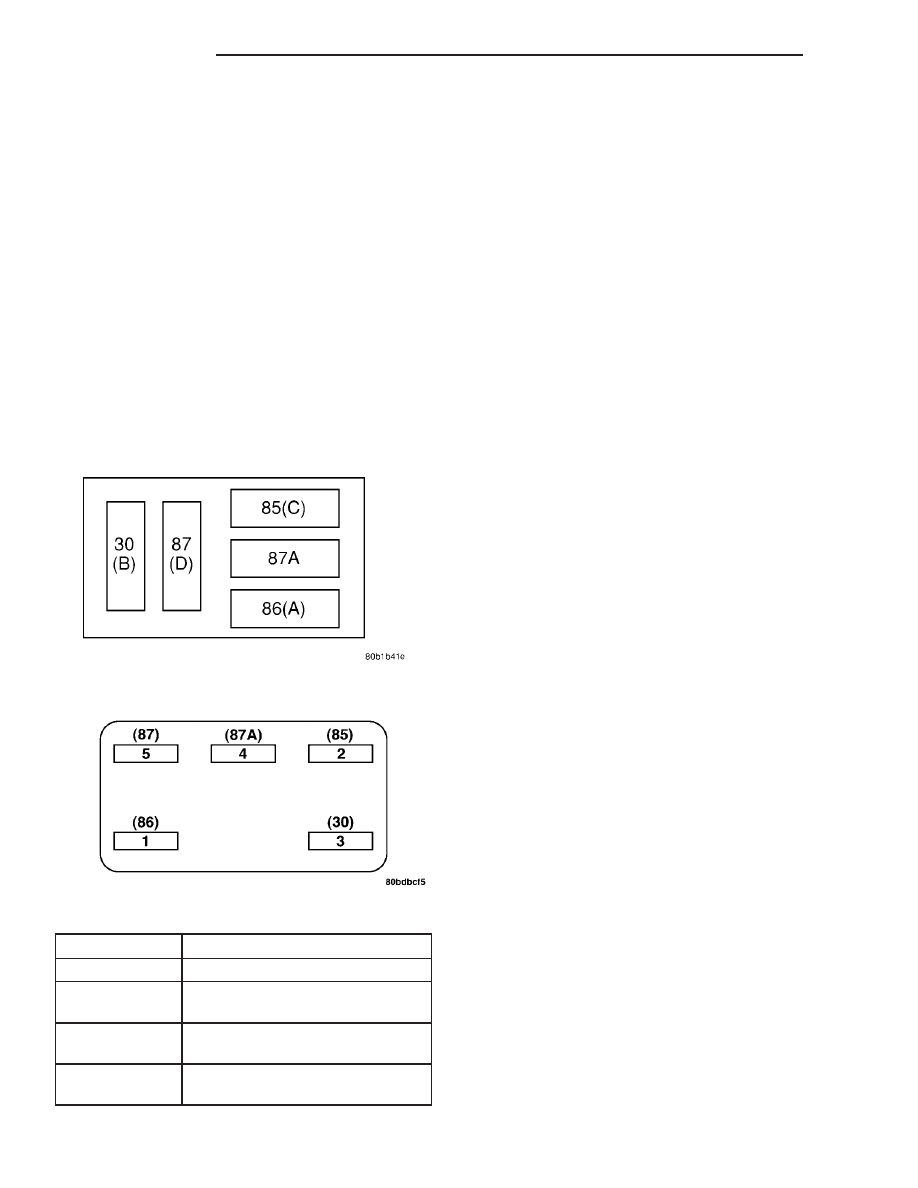Dodge Viper SRT-10 (ZB). Manual - part 66

RELAY TEST
The starter relay is located in the Power Distribu-
tion Center (PDC) in the engine compartment. Refer
to the PDC label for relay identification and location.
Remove
the
starter
relay
from
the
PDC
as
described in this group to perform the following tests:
(1) A relay in the de-energized position should
have continuity between terminals 87A and 30, and
no continuity between terminals 87 and 30. If OK, go
to Step 2. If not OK, replace the faulty relay.
(2) Resistance between terminals 85 and 86 (elec-
tromagnet) should be 75 ±5 ohms. If OK, go to Step
3. If not OK, replace the faulty relay.
(3) Connect a battery B+ lead to terminals 86 and
a ground lead to terminal 85 to energize the relay.
The relay should click. Also test for continuity
between terminals 30 and 87, and no continuity
between terminals 87A and 30. If OK, refer to Relay
Circuit Test procedure. If not OK, replace the faulty
relay.
CAV
FUNCTION
30
B (+)
85
P/N POSITION SW.SENSE
(AUTO)
86
IGNITION SWITCH OUT-
PUT
87
STARTER RELAY OUT-
PUT
RELAY CIRCUIT TEST
(1) The relay common feed terminal cavity (30) is
connected to battery voltage and should be hot at all
times. If OK, go to Step 2. If not OK, repair the open
circuit to the PDC fuse as required.
(2) The relay normally closed terminal (87A) is
connected to terminal 30 in the de-energized position,
but is not used for this application. Go to Step 3.
(3) The relay normally open terminal (87) is con-
nected to the common feed terminal (30) in the ener-
gized position. This terminal supplies battery voltage
to the starter solenoid field coils. There should be
continuity between the cavity for relay terminal 87
and the starter solenoid terminal at all times. If OK,
go to Step 4. If not OK, repair the open circuit to the
starter solenoid as required.
(4) The coil battery terminal (86) is connected to
the electromagnet in the relay. It is energized when
the ignition switch is held in the ON position after
depressing the clutch pedal. Check for battery volt-
age at the cavity for relay terminal 86 with the igni-
tion switch in the ON position and push the start
button after depressing the clutch pedal. If OK, go to
Step 5. If not OK, check for an open or short circuit
to the ignition switch and repair, if required. If the
circuit to the ignition switch is OK, see the Ignition
Switch Test procedure in this group.
(5) The coil ground terminal (85) is connected to
the electromagnet in the relay. It is grounded
through the PCM. Check for continuity between the
PCM and cavity for relay terminal 85.
SAFETY SWITCHES
If
diagnostics
of
the
Clutch
Interlock/Upstop
Switch, refer to Diagnosis and Testing in the Clutch
section.
IGNITION SWITCH
After testing starter solenoid and relay, test igni-
tion switch and wiring. Refer to the Ignition Section
or Wiring Diagrams for more information. Check all
wiring for opens or shorts, and all connectors for
being loose or corroded.
STARTER BUTTON
Check starter button and wiring. Refer to the Igni-
tion Section or Wiring Diagrams for more informa-
tion. Check all wiring for opens or shorts, and all
connectors for being loose or corroded.
BATTERY
For battery diagnosis and testing, refer to the Bat-
tery section for procedures.
ALL RELATED WIRING AND CONNECTORS
Refer to Wiring Diagrams for more information.
Starter Relay Pinout
Starter Relay Pinout
8F - 22
STARTING
ZB
STARTING (Continued)